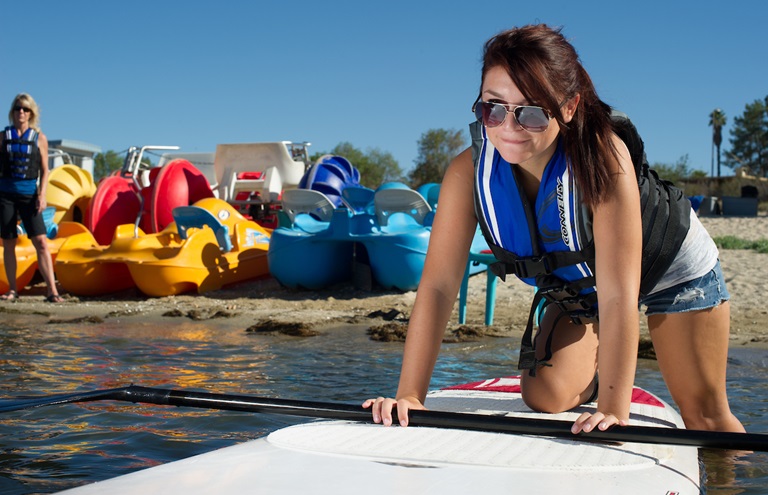Warm Weather, Cold Water: How to Stay Safe this Summer on California’s Waterways
Paddleboarder with life jacket on Lake Perris. DWR/2019 
Summer has arrived, and that means it is time to go outdoors for some swimming, fishing, boating, or picnicking on the beach. But hold on, before you get in the water, let’s talk safety first.
California experienced an above-average winter of rain and snow. With all that snow now melting in the Sierra, our rivers are running high, fast, and cold.
These frigid waters can be dangerous for swimmers who don’t take the necessary precautions. It’s hard to imagine freezing when it’s hot outside, but cold water reduces body heat 25 to 30 times faster than air does at the same temperature. This can quickly turn a good time into a life-threating situation. The Department of Water Resources (DWR) encourages you to take all the necessary safety precautions if you’re planning to head to one of California’s many beautiful rivers or lakes this summer.
Public safety is our priority. Here are basic tips you can follow:
- Always wear a life jacket when near the water
- If the water is too cold, stay out
- Obey all safety signs
- Learn to swim
- Always tell others where you are
- Know the symptoms of hypothermia
Hypothermia is a medical condition that occurs when your body loses heat faster than it can produce it. Having a very low body temperature is extremely dangerous, especially if you are in the water. We all know what cold feels like on land; however, in the water the danger increases due to the risk of losing body control, passing out, and drowning. Even mild hypothermia causes confused thinking that can impair decision-making and lead to risky behavior with dangerous consequences.
Signs and symptoms of hypothermia:
- Uncontrollable shivering
- Blue lips
- Slurred speech or mumbling
- Slow, shallow breathing
- Clumsiness or lack of coordination
- Drowsiness or very low energy
- Confusion or memory loss
- Bright red, cold skin
- Loss of consciousness
- Weak pulse
Someone with hypothermia usually is not aware of their condition because the symptoms often begin gradually, however, the colder the water, the faster it happens. Even water temperatures as high as 75 and 80 degrees Fahrenheit can be dangerous. Keep in mind that the average human body temperature is 98 degrees Fahrenheit and any temperature extreme that changes this average by 3 degrees can be dangerous to the body.
Prevention is the best way to save a person from drowning. Being aware of yourself and others is key. If you feel any of the symptoms of hypothermia or observe someone else having these symptoms, you must act quickly, get out of the water, seek help, and begin to gradually warm the body.
Gradual warming of the body can be done by:
- Changing into dry clothing
- Wrapping up in a blanket
- Going into a running car and turning on the heat
- Going indoors
- Standing near a fireplace
- Consuming easy to digest sugary foods or warm sugary drinks
- Applying heat through body-to-body contact, if necessary
- Seeking medical attention
It is best to always know your limits and keep a close eye on others, especially children. Always assign a designated adult to watch over children, and never assume someone else is watching them.
Spending an afternoon by the water should be a fun experience for the whole family. Following these tips and precautions will ensure everyone makes it home safe and sound.
